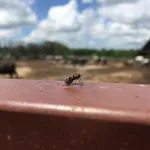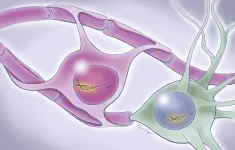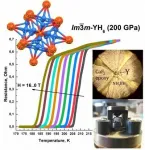(Press-News.org) Researchers hope to use an agricultural pest's genetic code against it to prevent billions of dollars in annual losses in the United States.
Stable flies, or Stomoxys calcitrans, are spotted, tan-colored flies found around the world. They are easily mistaken for the common housefly but for one notable distinction: They bite.
"If you get one in your house and it bites you, it's a stable fly," said Joshua Benoit, an assistant professor of biology at the University of Cincinnati.
Stable flies don't bite so much as chomp. They are the scourge of beachgoers in Florida and recreational boaters in upstate New York. According to Thomas Jefferson, they tormented signatories of the Declaration of Independence.
"You shoo it away and shoo it away but it's persistent and lands on you. And then it bites. And it's not a pleasant bite. It's a pretty vicious, painful bite," Benoit said.
UC joined an international team that unlocked the genome of stable flies. Benoit and his students contributed to a fundamental research project called i5k that has the ambitious goal to sequence the genes of 5,000 species of arthropods, the group that includes spiders, insects and crabs.
"It's a pretty cool project. Molecular research on stable flies is far behind many other organisms. Our goal was to jump it up so we have a good model system to understand the biology of stable flies," Benoit said.
Previously, UC worked on similar projects for bedbugs and the agricultural menaces thrips and screwworms.
With stable flies, Benoit said they were looking for possible weaknesses to exploit in its genetic code. Researchers examined stable fly biology using genomic sequencing and RNA analysis over the fly's development. They also identified 1,600 genes related to stable fly reproduction, which could lead to new biological controls without the use of pesticides.
"Conducting research for its own sake is reward enough, but it is always heartening when the findings generate interesting novel avenues for exploration," study co-author and UC postdoctoral researcher Christopher Holmes said.
The study was published in the journal BMC Biology. Pia Untalan Olafson of the U.S. Department of Agriculture was the study's lead author.
"Stable flies are arguably one of the most important pests of livestock in the United States," Olafson said.
The project has huge economic implications from tourism to agriculture. Nobody can nap in a beach chair with stable flies for company. The flies cause an estimated $2.2 billion in livestock production each year, according to the U.S. Department of Agriculture. Cows beset by stable flies produce less milk and put on less weight.
Unlike mosquitoes, both male and female stable flies bite.
"It's a nonstop onslaught all the time. The flies need a blood meal to survive and reproduce. So they will keep trying to bite and trying to bite. They are very persistent," Benoit said.
"When you get a thousand of these biting a cow, it can have a huge impact on agricultural productivity."
Olafson said the research has implications far beyond the United States.
"Worldwide, these flies have become a societal issue of public and political importance," she said. "Growing international agroindustries, like pineapple, coffee and sugarcane, produce large amounts of byproduct that are ideal sites for stable fly larvae to develop. These sites can produce upwards of hundreds of thousands of flies per acre. Livestock producers and communities that neighbor these industries feel the impact."
UC's study also helps scientists better understand why some flies evolved to feed on blood while similar species didn't. The flies lay their eggs in wet or rotting vegetation like the wet hay or straw found around barns and stables that give them their associated name.
By understanding the genes responsible for stable fly reproduction, researchers hope to design novel biological controls similar to methods that have worked to eradicate other pests such as screwworms. The USDA raises screwworms by the millions, releasing sterilized males over Central America to keep them from pushing north to plague North American cattle ranches.
"Any targeted control like that is probably better than widescale pesticide application, which will kill all insects. So you don't have to release chemicals into the environment," Benoit said.
INFORMATION:
DALLAS - March 10, 2021 - UT Southwestern scientists have identified key genes involved in brain waves that are pivotal for encoding memories. The END ...
Bacteria employ many different strategies to regulate gene expression in response to fluctuating, often stressful, conditions in their environments. One type of regulation involves non-coding RNA molecules called small RNAs (sRNAs), which are found in all domains of life. A new study led by researchers at the University of Illinois describes, for the first time, the impacts of sRNA interactions in individual bacterial cells. Their findings are reported in the journal Nature Communications, with the paper selected as an Editors' highlight article.
Bacterial sRNAs are often involved in regulating stress responses using mechanisms that involve base-pairing ...
While neurological complications of COVID-19 in children are rare, in contrast to adults, an international expert review of positive neuroimaging findings in children with acute and post-infectious COVID-19 found that the most common abnormalities resembled immune-mediated patterns of disease involving the brain, spine, and nerves. Strokes, which are more commonly reported in adults with COVID-19, were much less frequently encountered in children. The study of 38 children, published in the journal Lancet, was the largest to date of central nervous system imaging manifestations of COVID-19 in children.
"Thanks to a major international collaboration, we found that neuroimaging manifestations ...
When we recall a memory, we retrieve specific details about it: where, when, with whom. But we often also experience a vivid feeling of remembering the event, sometimes almost reliving it. Memory researchers call these processes objective and subjective memory, respectively. A new study from the Center for Mind and Brain at the University of California, Davis, shows that objective and subjective memory can function independently, involve different parts of the brain, and that people base their decisions on subjective memory -- how they feel about a memory -- more than on its accuracy.
"The study distinguishes between ...
Aspirin is an established, safe, and low-cost medication in long-standing common use in prevention and treatment of cardiovascular diseases, and in the past a pain relief and fever reducing medication. The use of aspirin was very popular during the 1918 Spanish Influenza pandemic, several decades before in-vitro confirmation of its activity against RNA viruses. Studies showed that aspirin, in addition to its well-known anti-inflammatory effects, could modulate the innate and adaptive immune responses helping the human immune system battle some viral infections.
With this information ...
Computer engineers at the world's largest companies and universities are using machines to scan through tomes of written material. The goal? Teach these machines the gift of language. Do that, some even claim, and computers will be able to mimic the human brain.
But this impressive compute capability comes with real costs, including perpetuating racism and causing significant environmental damage, according to a new paper, "On the Dangers of Stochastic Parrots: Can Language Models Be Too Big? ?" The paper is being presented Wednesday, March 10 at the ACM Conference on Fairness, Accountability and Transparency (ACM FAccT).
This is the first exhaustive review of the literature surrounding the risks that come with rapid growth of language-learning technologies, said ...
Effective, specific, with a reversible and non-harmful action: the identikit of the perfect biomaterial seems to correspond to graphene flakes, the subject of a new study carried out by SISSA - International School for Advanced Studies of Trieste, Catalan Institute of Nanoscience and Nanotechnology (ICN2) of Barcelona and the National Graphene Institute of the University of Manchester, in the framework of the European Graphene Flagship project. This nanomaterial has demonstrated the ability to interact with the functions of the nervous system in vertebrates in a very specific manner, interrupting the building up of a pathological process that leads ...
Healthcare personnel who were infected with COVID-19 had stronger risk factors outside the workplace than in their hospital or healthcare setting. That is the finding of a new study published today in JAMA Network Open conducted by University of Maryland School of Medicine (UMSOM) researchers, colleagues at the Centers for Disease Control and Prevention (CDC) and three other universities.
The study examined survey data from nearly 25,000 healthcare providers in Baltimore, Atlanta, and Chicago including at University of Maryland Medical System (UMMS) hospitals. They found that having a known exposure to someone who tested positive for COVID-19 in the community was the strongest risk factor for testing ...
An international team led by Artem R. Oganov, a Professor at Skoltech and MISIS, and Dr. Ivan Troyan from the Institute of Crystallography of RAS performed theoretical and experimental research on a new high-temperature superconductor, yttrium hydride (YH6). Their findings were published in the journal Advanced Materials.
Yttrium hydrides rank among the three highest-temperature superconductors known to date. The leader among the three is a material with an unknown S-C-H composition and superconductivity at 288 K, which is followed by lanthanum hydride, LaH10, superconducting at temperatures up to 259 K), and, finally, yttrium hydrides, YH6 and YH9, with maximum superconductivity temperatures of 224 K and 243 K, respectively. The superconductivity of YH6 ...
Boston - A new study shows that providing a non-acute care space after hospital discharge for patients with COVID-19 who are experiencing homelessness helped reduce hospitalizations and keep inpatient beds available for those requiring acute care. Published in JAMA Network Open and led by researchers at Boston Medical Center's (BMC) Grayken Center for Addiction, the study demonstrates the importance of developing innovative approaches to tackle issues facing people experiencing homelessness, including their inability to isolate, in order to mitigate additional ...



